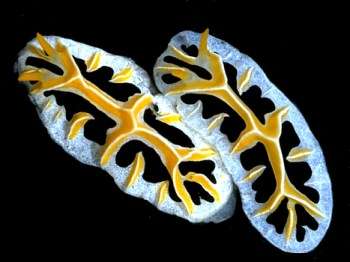
Reticulidia fungia
Brunckhorst & Gosliner in Brunckhorst, 1993
Order: NUDIBRANCHIA
Suborder: DORIDINA
Family: Phyllidiidae
DISTRIBUTION
Known from the central to western Pacific Ocean (including Fiji and Micronesia), from eastern Australia to Taiwan. Also known from Christmas Island, Bali, and Ningaloo Reef, WA., in the eastern Indian Ocean.
PHOTO
14m depth, Horseshoe Reef, outer barrier reef, southern Papua New Guinea, dorsal view of 28 and 30 mm specimens, 22 June 1988. PHOTO: D. Brunckhorst. (Brunckhorst, 1993: Plate 9H).
Notes compiled from Brunckhorst, 1993:
Reticulidia fungia is the second species of Reticulidia Brunckhorst and it confirms generic features previously described (Brunckhorst, 1990). Reticulidia fungia apparently does not attain the size of Reticulidia halgerda. Reticulidia fungia is separable from R. halgerda by having: broad based ridges which are fewer in number, the bases being finely bordered in white; a broad blue-grey mantle margin (narrow and orange in R. halgerda); paler coloration ventrally, a black line around the side of the foot just above the gills; and rhinophores with 14-18 lamellae on the clavus (24-28 in R. halgerda).
Reference:
• Brunckhorst, D.J. (1993) The systematics and phylogeny of Phyllidiid Nudibranchs (Doridoidea). Records of the Australian Museum, Supplement 16: 1-107.
Rudman, W.B., 1999 (November 28) Reticulidia fungia Brunckhorst & Gosliner in Brunckhorst, 1993. [In] Sea Slug Forum. Australian Museum, Sydney. Available from http://www.seaslugforum.net/find/retifung
Related messages
Reticulidia fungia from Ningaloo Reef West Australia
May 24, 2006
From: Chris Cunnold
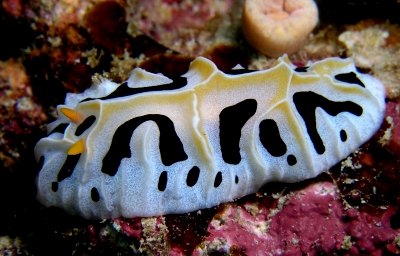
Dear Bill,
I have noticed that there are no mainland Australia sightings of Reticulidia fungia on the forum. This observation may add to the distribution of the species.
Locality: Ningaloo Reef, North of Coral Bay, 26m, Western Australia, Indian Ocean, 9 May 2006, Reef Ledge. Length: 60mm. Photographer: Chris Cunnold.
Regards,
Chris
cunnold@iinet.net.au
Cunnold, C., 2006 (May 24) Reticulidia fungia from Ningaloo Reef West Australia. [Message in] Sea Slug Forum. Australian Museum, Sydney. Available from http://www.seaslugforum.net/find/16681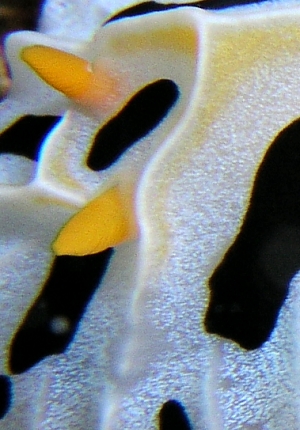
Dear Chris,
Thanks for this. Although we don't have a Forum record of it from the Australian mainland, it is known from the Great Barrier Reef. However yours is the first record from the west coast. I guess the only other Indian Ocean records are those on the Forum from Bali and Christmas Island.
I have inckdued a close-up to show the small white specks all over the mantle which are gland 'cells' which either produce, or store, the milky secretion which the animal exudes from its skin when stressed.
Best wishes,
Bill Rudman
Re: Reticulidia fungia from Bali
January 27, 2005
From: Rainer Mau
Bill,
thanks a lot for your interesting reply,
have learned a lot and will continue to bother you with other unidentified nudies to follow soon
Cheers
Rainer
rainer.mau@hansenet.de
Mau, R., 2005 (Jan 27) Re: Reticulidia fungia from Bali. [Message in] Sea Slug Forum. Australian Museum, Sydney. Available from http://www.seaslugforum.net/find/13020Reticulidia fungia from Bali
January 2, 2005
From: Rainer Mau

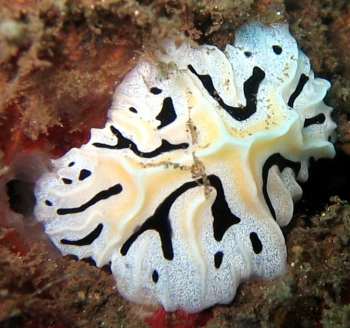
Dear Bill,
The picture of the attached species was taken during a dive in the waters off north-east Bali, precisely at the house reef of the small resort Alam Anda.
In the book Nudibranchs of the South Pacific, Vol 1, by Neville Coleman, the species has the common name "Abstract Phyllidia", however, no scientific name is cited.
Locality: House reef, Alam Anda, Bali, Indonesia, Java Sea
Depth: 18 meters. Length: 20 mm. 16 December 2004
House reef below coral head
Photographer: Rainer Mau
Your help is really appreciated.
Cheers
Rainer
rainer.mau@hansenet.de
Mau, R., 2005 (Jan 2) Reticulidia fungia from Bali. [Message in] Sea Slug Forum. Australian Museum, Sydney. Available from http://www.seaslugforum.net/find/12875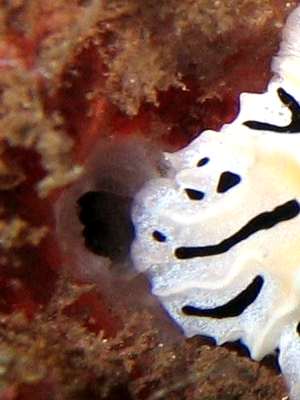
Dear Rainer,
This is Reticulidia fungia. At the time Neville's book was published it did not have a scientific name. 'Common names' in photo books like this are a bit of a misnomer. They are 'common' in the sense they use 'common' everyday English. They are certainly not 'common' in the sense they are commonly used for the species. In fact the common names were made up for that book. 'Common names' are not very helpful because they differ from book to book. I would encourage you to use scientific names - where they exist - because they are understood worldwide and so are the real 'common name' for each species.
Your animal is a particularly pale form of the species, the yellow being quite pale and the black region reduced to bands. Your lower photo, which I have included a close-up of alongside, is also very interesting because it shows a hole in the reddish sponge which looks like it could have been eaten out by the nudibranch. The family Phyllidiidae, to which Reticulidia belongs, have no teeth or hard parts to assist in feeding, the animals feeding by dissolving the sponge tissue externally and sucking the half-digested soup into their mouth. I suspect the hole you can see is a burrow or some other natural phenomenon, but the bare whitish tissue you can see appears to be damaged sponge tissue. An interesting observation, because we know so little about feeding in these animals, and nothing about feeding in this species.
Best wishes,
Bill Rudman
Re: Reticulidia fungia from Vanuatu
June 21, 2004
From: Nick Hobgood
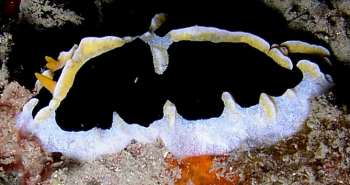
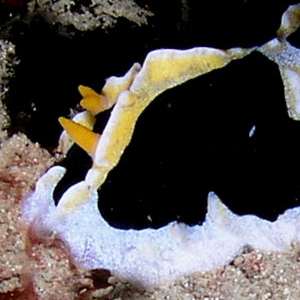
Dr. Bill,
I am so sad to see news of the Forum's closure!! I really enjoyed looking through the photos and posts.
I know you are doing this on your spare time but would like to send this picture of what looks like a Reticulidia fungia but with two sets of rhinopores and all the photos I have seen so far only have one pair. Is this normal?
Thanks
Nick Hobgood
East Timor
nick@congo-pages.org
Hobgood, N., 2004 (Jun 21) Re: Reticulidia fungia from Vanuatu. [Message in] Sea Slug Forum. Australian Museum, Sydney. Available from http://www.seaslugforum.net/find/12654Dear Nick,
I assume this photo is from East Timor? The problems with the Forum are not as yet resolved but I am hoping to spend some time on it each week.
This is indeed Reticulidia fungia. The 'double' rhinophores are a developmental mistake. Have a look at the abnormalities page where I have listed the many photos we now have of such abnormalities.
Best wishes
Bill Rudman
Colour variation in Reticulidia fungia from Philippines
June 10, 2002
From: Fredy Brauchli
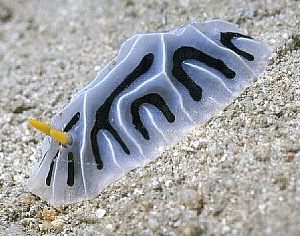
Hello Bill
As far as I can see, the colour pattern of Reticulidia fungia is quite variable.
Here is a record from Pandan Island, Occ. Mindoro, Philippines.
Size: ca. 3 cm, depth: 12m, place: Neptun's Land, date: March 29th 2002.
Kind regards,
Fredy
http://www.subaqua.ch
brauchli@subaqua.ch
Brauchli, F., 2002 (Jun 10) Colour variation in Reticulidia fungia from Philippines. [Message in] Sea Slug Forum. Australian Museum, Sydney. Available from http://www.seaslugforum.net/find/7113Thanks Fredy,
It's only through contributions like yours that we can build up a knowledge of how variable many of these species are. I agree with your suggestion that is probably a colour variation of R. fungia which lacks any yellow on the mantle. Have you seen any other colour variations - perhaps with a little yellow on the mantle?
Best wishes,
Bill Rudman
Reticulidia fungia from Christmas Island
May 10, 2002
From: W.B. Rudman

Here is some information and photos on Reticulidia fungia from John Hicks' Christmas Island, Indian Ocean collections.
PHOTO: AM C126996, 27 mm long alive. 3 December 1980, off mosque near buoy, under coral overhang, 26 m, Christmas Is., Indian Ocean. Photo: John Hicks
Best wishes,
Bill Rudman
Reticulidia fungia from the Solomon Islands
February 4, 2001
From: Mary Jane Adams
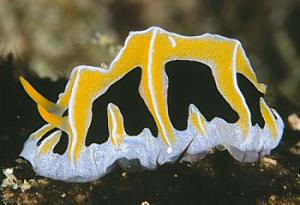
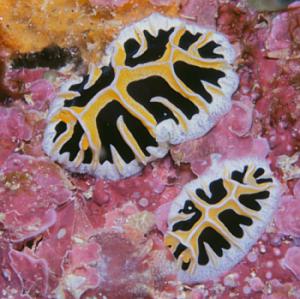
Hi Bill,
Here are some Reticulidia fungia from Marovo Lagoon in the Solomon Islands.
UPPER PHOTO: was inside Rapichana Cut. Length: 40mm Depth: 8 meters November, 2000.
LOWER PHOTO: is from divesite 'George's Night Spot." Length: 15 and 22 mm Depth: 7 meters
November, 1999
Best regards,
Mary Jane
divepng@yahoo.com
Adams, M.J., 2001 (Feb 4) Reticulidia fungia from the Solomon Islands. [Message in] Sea Slug Forum. Australian Museum, Sydney. Available from http://www.seaslugforum.net/find/3694Thanks Mary Jane
Bill Rudman
Reticulidia fungia from the Solomon Ids
October 16, 2000
From: Bruce Potter
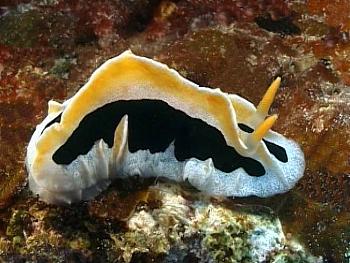
Dear Bill,
Here is a photo of Reticulidia fungia from a recent trip to Russell Islands in the Solomons. This is my first sighting of this pretty slug. It was 10 meters down a vertical wall near Leru Cut dive site.
Bruce Potter
bruce.potter@adventist.org.sb
Potter, B., 2000 (Oct 16) Reticulidia fungia from the Solomon Ids. [Message in] Sea Slug Forum. Australian Museum, Sydney. Available from http://www.seaslugforum.net/find/3167Dear Bruce,
This helps fill in a gap in the distribution record of the species.
Best wishes,
Bill Rudman.
Reticulidia fungia variation from Marshall Ids
December 9, 1999
From: Scott Johnson
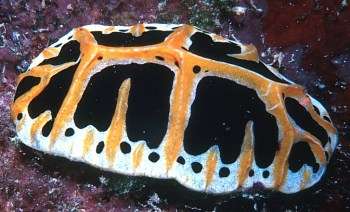
Hi Bill,
Here's a minor variation in coloration in Reticulidia fungia. Of perhaps a half dozen specimens seen here in the Marshall Islands, this was the only one with black spotting within the marginal band and along the edge of the middorsal ridge.
Scott
johnson@kmr.ll.mit.edu
Thanks Scott,
Bill Rudman.
Reticulidia fungia from Vanuatu
November 28, 1999
From: Vinka Stenhouse
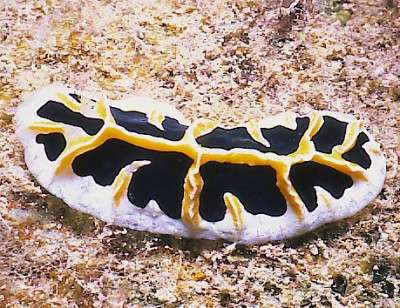
Dear Bill,
This one is from, 23m, Espiritu Santo Is., Vanuatu. 1993. It was 4cm long. PHOTO: J.K. Stenhouse.
Yours sincerely,
Vinka Stenhouse.
Santo.
Vanuatu.
Dear Vinka,
This is one of the Halgerda - looking phyllidiid species, Reticulidia fungia. Like other phyllidiids, this species and Reticulidia halgerda can be distinguished from species of Halgerda externally by the lack of dorsal gills. Of course if you dissect them, the quite different foregut, which lacks a radula, clearly indicates that they are not normal dorids.
Best wishes,
Bill Rudman.
